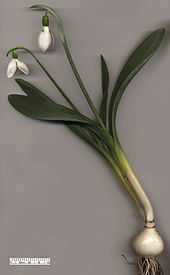Moly (herb)

Moly (Greek: μῶλυ, [môly]) is a magical herb mentioned in book 10 of Homer's Odyssey.[1]
In the story, Hermes gave this herb to Odysseus to protect him from Circe's magic when he went to her home to rescue his friends.[2] These friends came together with him from the island Aiolos after they escaped from the Cyclops. "The plant 'moly' of which Homer speaks; this plant, it is said, had grown from the blood of the Giant Picolous killed in the isle of Kirke; it has a white flower; the ally of Kirke who killed Picolous was Helios (the Sun); the combat was hard (Greek malos) from which came the name of this plant".[3] Homer also describes Moly by saying "The root was black, while the flower was as white as milk; the gods call it Moly, Dangerous for a mortal man to pluck from the soil, but not for the deathless gods. All lies within their power".[4]
There has been much controversy as to the identification. Philippe Champault decides in favour of the Peganum harmala (of the order Rutaceae),[5] the Syrian or African rue (Greek πἠγανον), from the husks of which the vegetable alkaloid harmaline is extracted. The flowers are white with green stripes. Victor Bérard relying partly on a Semitic root,[6] prefers the Atriplex halimus (atriplex, a Latin form of Greek ἀτράφαξυς, and ἅλιμος, marine), order Chenopodiaceae, a herb or low shrub common on the south European coasts. These identifications are noticed by R. M. Henry,[7] who illustrates the Homeric account by passages in the Paris and Leiden magical papyri, and argues that moly is probably a magical name, derived perhaps from Phoenician or Egyptian sources, for a plant which cannot be certainly identified. He shows that the "difficulty of pulling up" the plant is not a merely physical one, but rather connected with the peculiar powers claimed by magicians.[7] In Tennyson's The Lotos-Eaters, the moly is coupled with the amaranth ("propt on beds of amaranth and moly").[2] Carl Linnaeus referenced the mythical plant with Allium moly, the scientific name for golden garlic, though of course the perianth of this species is yellow, not white.
Medical historians have speculated that the transformation to pigs was not intended literally but refers to anticholinergic intoxication.[8] Symptoms include amnesia, hallucinations, and delusions. The description of "moly" fits the snowdrop, a flower of the region that contains galantamine, which is an anticholinesterase and can therefore counteract anticholinergics.
Notes
- ↑ Chisholm 1911, p. 681 cites: Homer, Odyssey, x. 302–306.
- ↑ 2.0 2.1 Chisholm 1911, p. 681.
- ↑ HELIUS : Greek Titan god of the sun
- ↑ Homer & Butler 1898, Book X.
- ↑ Chisholm 1911, p. 681 cites: Phéniciens et Grecs en Italie d'après l'Odyssée (1906), pp. 504 seq.
- ↑ Chisholm 1911, p. 681 cites: Victor Bérard Les Phéniciens et l'Odyssee, ii. 288 seq.
- ↑ 7.0 7.1 Chisholm 1911, p. 681 cites: R. M. Henry Class. Rev. (Dec. 1906), p. 434.
- ↑ Andreas Plaitakis & Roger C. Duvoisin (1983). "Homer's moly identified as Galanthus nivalis L.: physiologic antidote to stramonium poisoning". Clinical Neuropharmacology 6 (1): 1–5. doi:10.1097/00002826-198303000-00001. PMID 6342763.
References
- Homer; Butler, Samuel (1898), The Odyssey, Book X
- Attribution
-
 This article incorporates text from a publication now in the public domain: Chisholm, Hugh, ed. (1911). "Moly". Encyclopædia Britannica 18 (11th ed.). Cambridge University Press. p. 681.
This article incorporates text from a publication now in the public domain: Chisholm, Hugh, ed. (1911). "Moly". Encyclopædia Britannica 18 (11th ed.). Cambridge University Press. p. 681.